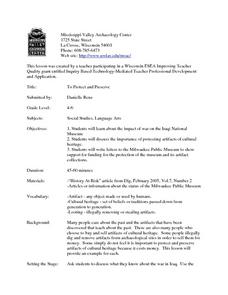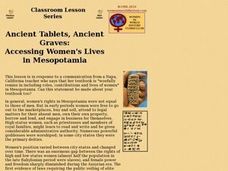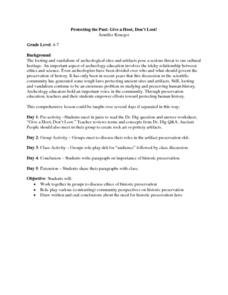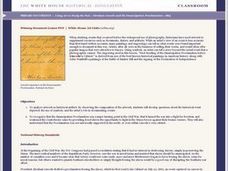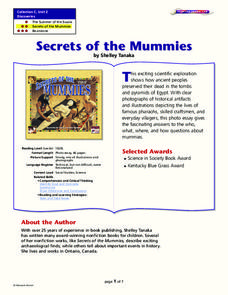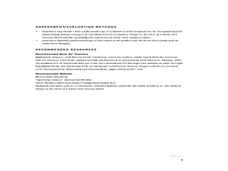Curated OER
To Protect and Preserve
Students discuss the impact of war on the Iraqi National Museum and the importance of protecting artifacts of cultural heritage. They write letters to the Milwaukee Public Museum to show support for funding for the protection of the...
Global Oneness Project
After the Quake: Preserving the Artifacts of Kathmandu
On April 28, 2015, a 7.8 earthquake ruptured the Kathmandu Valley in Nepal. Seven UNESCO World Heritage sites are located in this valley. The efforts of experts and archeologists to restore three of them—Kathmandu Durbar Square, Patan...
Curated OER
Marine Archaeology
Students examine marine archaeology. In this archaeological data lesson, students see how archaeologists use data to make inferences about shipwrecks. Students read data and make their own inferences, write about marine life and...
Curated OER
Ancient Tablets, Ancient Graves: Accessing Women's Lives in Mesopotamia
Students explore the role of women in ancient Mesopotamia. Several excerpts from the Mesopotamian cuneiform tablets and artifacts are analyzed to determine the treatment, rights, and powers of women in this era.
Curated OER
Protecting the Past: Give a Hoot, Don't Loot!
Students, in small groups, simulate an ancient civilization and the art they created, another group represents vandals, and the final group represents archaeologists who try to figure out what life was like for the "ancient peoples". ...
Curated OER
Artifact Ethics
Fourth graders examine their own values and beliefs about archaeological site protection and evaluate possible actions they might take regarding site and artifact protection.
Curated OER
Political statements and protected speech
Learners research and investigate what laws exist about freedom of speech. They write an article about this topic. Students interview the learners at their school on this topic. They take a stand and support their stand with facts.
Roy Rosenzweig Center for History and New Media
American Indians and their Environment
People could take a page in ingenuity and survival from the Powhatans. Deer skins became clothes, and the members of the Native American group farmed the rich Virginia soil and hunted in its forests for food. Using images of artifacts...
Curated OER
Does This Belong to You?
Fourth graders examine legislation that has been passed to protect the rights and religion of Native Americans. In groups, they discuss their feelings on others taking artifacts from Native American sites and what they do if they find...
Curated OER
Protecting the Past: Give a Hoot, Don't Loot
Students discuss the looting and vandalism of various archeological sites. In pairs, they read and complete a worksheet and review their answers as a class. In groups, they role play a artifact preservation skit and perform it to their...
Curated OER
Southeastern Native Americans' Lifestyles
Students complete activities to learn about Southeastern Native Americans. In this lifestyles instructional activity, students watch a PowerPoint about Southeastern Native Americans, view artifacts from the region and discuss the...
Curated OER
Ancient Egypt/Mummification/Preservation
Sixth graders identify characteristics of preserved artifact, distinguish between an example and non-example of a preserved artifact, and connect the definition of preserve to the Egyptian art of mummification.
Curated OER
To Dig or Not to Dig: The Stadium Showdown
Students examine an ethical public dilemma. In this cultural resource lesson, students role play to examine their personal beliefs regarding the protection of cultural resources. They evaluate possible actions they can take to protect...
Curated OER
Using Art to Study the Past: Abraham Lincoln and the Emancipation Proclamation - 1863
Fifth graders analyze artwork as historical artifact and recognize that the Emancipation Proclamation was a major turning point in the Civil War.
Curated OER
Ethics in Archeology
Students discuss their views about archeological site protection. They analyze different dilemmas dealing with this issue and discuss. They discover the importance of protecting artifacts and archeological sites.
Forest Foundation
The Sustainable Forest
As part of their examination of forest ecosystems, class members examine how foresters, biologists, botanists, geologists, and hydrologists work to together to develop a management plan for sustainable forests.
Curated OER
Secrets of the Mummies
How did the ancient people of Egypt preserve their dead so well that their bodies are still recognizable today? Learn the painstakingly complex process they used for preservation. Young scholars read and summarize a narrative detailing...
Curated OER
Keeping safe from carbon monoxide
High schoolers research tips on what to do to avoid problems or to recognize dangers if they exist. Find local gas companies and fire department officials who have background in this. Then plan an article telling your readers what they...
Curated OER
Exploring Hybrid Cars
Students explore GreenHybird.com and develop a list of questions car buyers might have. Students also attempt to answer the questions on GreenHybrid.com and then explore the answers with car dealers in the area before writing a clear and...
Curated OER
What's Missing?
Students examine their beliefs about archaeological preservation. They articulate a response to archaeological resource destruction. Students then complete two puzzles and relate them to archaeological research.
Curated OER
Saving the Past for the Future
Students discuss an archaeological dilemma. They write a paragraph about possible solutions to the problem.
Curated OER
We the People
Learners examine both the Preamble of the Constitution and the Bill of Rights. They work in small groups to connect the two documents and analyze how the documents are important to their lives today. They create a poster that visually...
Curated OER
Symmetry and Symbols
Students identify symmetrical and congruent elements in folk art. In this art and geometry lesson, students examine pictures of Masonic Plaque in the Form of a Royal Arch Tracing Board for evidence of congruent and symmetrical elements....
Curated OER
Homeless awareness on a cold night
Students conduct research on issues and interests by generating ideas and questions and posing problems. They use a variety of technological and informational resources to gather and synthesize information and to create and communicate...
